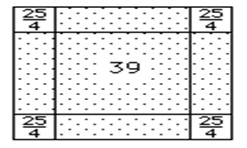Al-Khwarizmi, the father of modern mathematics try to solve the following: One square and ten roots of the same are equal to thirty-nine dirhems - What must be the square that when increased by ten of its own roots, amounts to thirty-nine?
1 Answer
Answer is
Explanation:
As the problem states that
"what must be the square that when increased by ten of its own roots, amounts to thirty-nine"
it means if the number is
or
or
i.e.
i.e.
Hence, either
It may, however, be noted that in the times of Al-Khwarizmi, negative numbers were not considered and further, the problem emanates from the geometric problem represented by following figure (not drawn to scale - it is in fact a square),

where Al-Khwarizmi sought solution to the side of inner square, where shaded area that forms the box is
As it was essentially a geometric figure,
